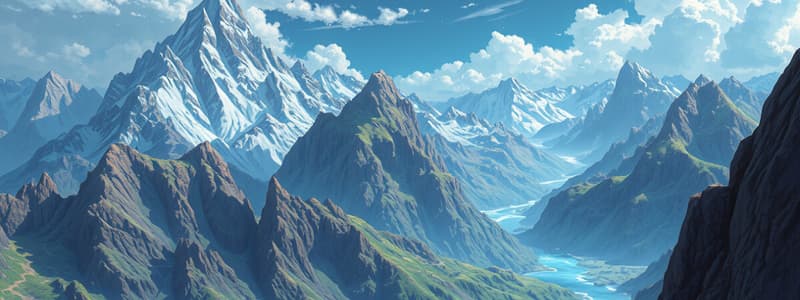Podcast
Questions and Answers
What are the four main types of mountains?
What are the four main types of mountains?
- Fault-Block Mountains (correct)
- Volcanoes (correct)
- Convergent Mountains (correct)
- Dome Mountains (correct)
What are Volcanoes?
What are Volcanoes?
Volcanoes are formed when gas-rich molten rock moves to the surface, erupts, and accumulates.
What are Convergent Mountains?
What are Convergent Mountains?
Convergent Mountains are formed by the collision of two plates at convergent boundaries.
Describe the Appalachians.
Describe the Appalachians.
What are Fault-Block Mountains?
What are Fault-Block Mountains?
What are Dome Mountains?
What are Dome Mountains?
Flashcards are hidden until you start studying
Study Notes
Types of Mountains
- Four primary types of mountains: Fault-Block, Convergent, Volcanoes, and Dome Mountains.
Volcanoes
- Found on all continents, contributing significantly to mountain formation.
- Formed from gas-rich molten rock (magma) that erupts, cools, and accumulates.
- Associated with three tectonic regions:
- Rift-valley spreading centers
- Convergent boundaries (subduction)
- Intraplate hotspots
Convergent Mountains
- Home to the largest mountain ranges globally, including the Himalayas, Andes, European Alps, Rockies, and Appalachians.
- Result from the collision of tectonic plates at convergent boundaries.
- Continental crust cannot subduct, leading to rock shortening and compression, resulting in uplifting.
- Geologic formations include:
- Synclines
- Anticlines
- Recumbent folds
- Thrust faults
- Imbricate thrust faults
Case Study: The Appalachians
- An example of inactive convergent mountains.
- Once as tall as the modern Himalayas during the formation of the supercontinent Pangea.
Fault-Block Mountains
- Form from faults in the earth's crust causing surface sections to rise or fall.
- Example: The Teton Range in the American Rockies, formed from faulting less than ten million years ago.
- Movement is slow and occurs in jerky shifts over thousands to millions of years.
Dome Mountains
- Result from magma pushing up beneath the earth's crust without erupting.
- Erosion can eventually expose the dome-shaped hard rock formed from cooled magma.
Studying That Suits You
Use AI to generate personalized quizzes and flashcards to suit your learning preferences.




